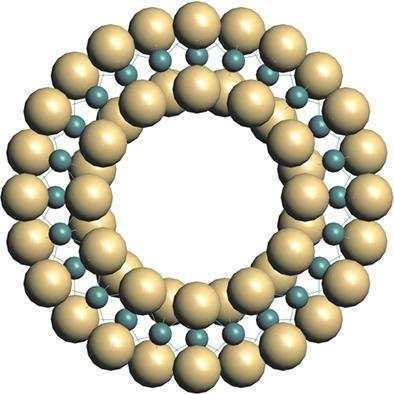当前位置:
X-MOL 学术
›
J. Comput. Chem.
›
论文详情
Our official English website, www.x-mol.net, welcomes your feedback! (Note: you will need to create a separate account there.)
Infrared and Raman active vibrational modes in MoS2 -based nanotubes: Symmetry analysis and first-principles calculations
Journal of Computational Chemistry ( IF 3 ) Pub Date : 2018-10-05 , DOI: 10.1002/jcc.25530 Robert A. Evarestov 1 , Andrei V. Bandura 1
Journal of Computational Chemistry ( IF 3 ) Pub Date : 2018-10-05 , DOI: 10.1002/jcc.25530 Robert A. Evarestov 1 , Andrei V. Bandura 1
Affiliation

|
The possibility to use the axial point group dynamical representations for the infrared and Raman active modes classification in nanotubes is analyzed. The method proposed allows one to obtain the results of phonon symmetry analysis for nanotubes in Mulliken designations, which are traditional for molecules and crystallographic point groups. The approach suggested is applied to the phonon symmetry analysis in the single‐wall carbon and MoS2‐based nanotubes. First‐principles calculations of phonons in a bulk MoS2 crystal and a monolayer S‐Mo‐S are made. The results obtained are in reasonable agreement with the existing experimental data and other published results. The first‐principles calculations of the phonon frequencies for armchair and zigzag MoS2 nanotubes are performed for the first time. It is shown that the number of infrared and Raman active modes becomes fixed starting from the relatively small nanotube diameters. The correlation of the phonon modes of MoS2 nanotubes with diameters up to 3.64 nm with phonon modes of the S‐Mo‐S monolayer is analyzed. It is demonstrated that the interpretation of the nature of nanotube A‐type modes in the crystallographic factorization of the line group L = TF is the same as for m = 0 modes in the “polymer type” factorization L = ZP where P is the subgroup of the isogonal point group F, T is the translation subgroup of line group and the cyclic group Z includes the one‐dimensional translations and the rotations around the screw axes or the reflections in the glide planes. © 2018 Wiley Periodicals, Inc.
中文翻译:

基于二硫化钼的纳米管中的红外和拉曼主动振动模式:对称性分析和第一性原理计算
分析了在纳米管中使用轴向点群动力学表示进行红外和拉曼有源模式分类的可能性。所提出的方法允许人们获得以马利肯命名的纳米管声子对称性分析的结果,这是分子和结晶点群的传统名称。所建议的方法应用于单壁碳和二硫化钼基纳米管中的声子对称性分析。进行了块状 MoS2 晶体和单层 S-Mo-S 中声子的第一性原理计算。获得的结果与现有的实验数据和其他已发表的结果具有合理的一致性。首次对扶手椅和锯齿形 MoS2 纳米管的声子频率进行第一性原理计算。结果表明,从相对较小的纳米管直径开始,红外和拉曼有源模式的数量变得固定。分析了直径高达 3.64 nm 的 MoS2 纳米管的声子模式与 S-Mo-S 单层的声子模式的相关性。结果表明,线群 L = TF 的晶体分解中纳米管 A 型模式的性质的解释与“聚合物类型”分解中的 m = 0 模式相同 L = ZP 其中 P 是子群等角点群 F 的 T 是线群的平移子群,循环群 Z 包括一维平移和绕螺旋轴的旋转或滑翔平面的反射。© 2018 Wiley Periodicals, Inc. 分析了直径高达 3.64 nm 的 MoS2 纳米管的声子模式与 S-Mo-S 单层的声子模式的相关性。结果表明,线群 L = TF 的晶体分解中纳米管 A 型模式的性质的解释与“聚合物类型”分解中的 m = 0 模式相同 L = ZP 其中 P 是子群等角点群 F 中,T 是线群的平移子群,循环群 Z 包括一维平移和绕螺旋轴的旋转或滑翔平面内的反射。© 2018 Wiley Periodicals, Inc. 分析了直径高达 3.64 nm 的 MoS2 纳米管的声子模式与 S-Mo-S 单层的声子模式的相关性。结果表明,线群 L = TF 的晶体分解中纳米管 A 型模式的性质的解释与“聚合物类型”分解中的 m = 0 模式相同 L = ZP 其中 P 是子群等角点群 F 的 T 是线群的平移子群,循环群 Z 包括一维平移和绕螺旋轴的旋转或滑翔平面的反射。© 2018 Wiley Periodicals, Inc. 结果表明,线群 L = TF 的晶体分解中纳米管 A 型模式的性质的解释与“聚合物类型”分解中的 m = 0 模式相同 L = ZP 其中 P 是子群等角点群 F 的 T 是线群的平移子群,循环群 Z 包括一维平移和绕螺旋轴的旋转或滑翔平面的反射。© 2018 Wiley Periodicals, Inc. 结果表明,线群 L = TF 的晶体分解中纳米管 A 型模式的性质的解释与“聚合物类型”分解中的 m = 0 模式相同 L = ZP 其中 P 是子群等角点群 F 的 T 是线群的平移子群,循环群 Z 包括一维平移和绕螺旋轴的旋转或滑翔平面的反射。© 2018 Wiley Periodicals, Inc.
更新日期:2018-10-05
中文翻译:

基于二硫化钼的纳米管中的红外和拉曼主动振动模式:对称性分析和第一性原理计算
分析了在纳米管中使用轴向点群动力学表示进行红外和拉曼有源模式分类的可能性。所提出的方法允许人们获得以马利肯命名的纳米管声子对称性分析的结果,这是分子和结晶点群的传统名称。所建议的方法应用于单壁碳和二硫化钼基纳米管中的声子对称性分析。进行了块状 MoS2 晶体和单层 S-Mo-S 中声子的第一性原理计算。获得的结果与现有的实验数据和其他已发表的结果具有合理的一致性。首次对扶手椅和锯齿形 MoS2 纳米管的声子频率进行第一性原理计算。结果表明,从相对较小的纳米管直径开始,红外和拉曼有源模式的数量变得固定。分析了直径高达 3.64 nm 的 MoS2 纳米管的声子模式与 S-Mo-S 单层的声子模式的相关性。结果表明,线群 L = TF 的晶体分解中纳米管 A 型模式的性质的解释与“聚合物类型”分解中的 m = 0 模式相同 L = ZP 其中 P 是子群等角点群 F 的 T 是线群的平移子群,循环群 Z 包括一维平移和绕螺旋轴的旋转或滑翔平面的反射。© 2018 Wiley Periodicals, Inc. 分析了直径高达 3.64 nm 的 MoS2 纳米管的声子模式与 S-Mo-S 单层的声子模式的相关性。结果表明,线群 L = TF 的晶体分解中纳米管 A 型模式的性质的解释与“聚合物类型”分解中的 m = 0 模式相同 L = ZP 其中 P 是子群等角点群 F 中,T 是线群的平移子群,循环群 Z 包括一维平移和绕螺旋轴的旋转或滑翔平面内的反射。© 2018 Wiley Periodicals, Inc. 分析了直径高达 3.64 nm 的 MoS2 纳米管的声子模式与 S-Mo-S 单层的声子模式的相关性。结果表明,线群 L = TF 的晶体分解中纳米管 A 型模式的性质的解释与“聚合物类型”分解中的 m = 0 模式相同 L = ZP 其中 P 是子群等角点群 F 的 T 是线群的平移子群,循环群 Z 包括一维平移和绕螺旋轴的旋转或滑翔平面的反射。© 2018 Wiley Periodicals, Inc. 结果表明,线群 L = TF 的晶体分解中纳米管 A 型模式的性质的解释与“聚合物类型”分解中的 m = 0 模式相同 L = ZP 其中 P 是子群等角点群 F 的 T 是线群的平移子群,循环群 Z 包括一维平移和绕螺旋轴的旋转或滑翔平面的反射。© 2018 Wiley Periodicals, Inc. 结果表明,线群 L = TF 的晶体分解中纳米管 A 型模式的性质的解释与“聚合物类型”分解中的 m = 0 模式相同 L = ZP 其中 P 是子群等角点群 F 的 T 是线群的平移子群,循环群 Z 包括一维平移和绕螺旋轴的旋转或滑翔平面的反射。© 2018 Wiley Periodicals, Inc.



























 京公网安备 11010802027423号
京公网安备 11010802027423号